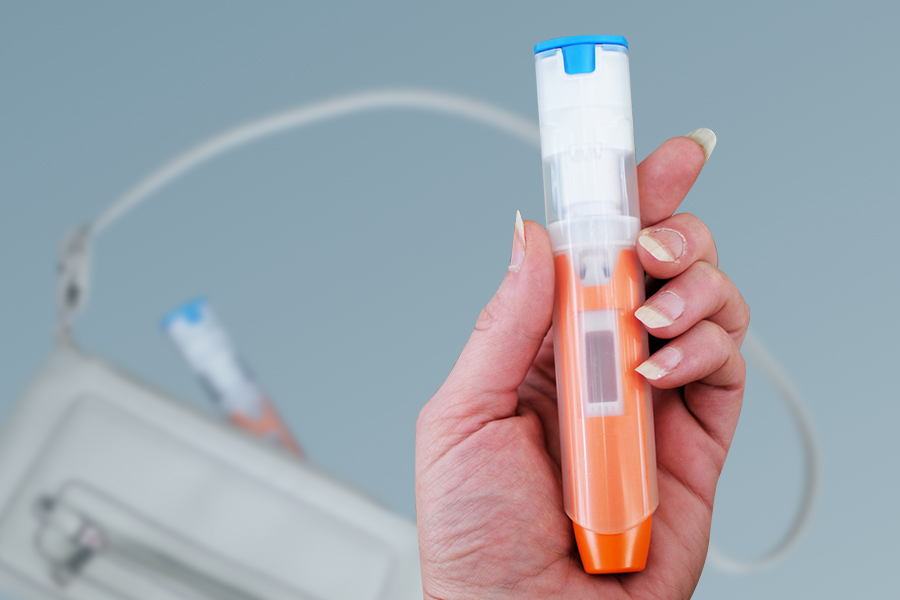The past 20 years have seen significant progress in the treatment of chronic diseases, with the development of biologic pharmaceuticals to treat a wide range of chronic conditions, including autoimmune diseases, multiple sclerosis, migraine, hypercholesterolemia, and atherosclerotic cardiovascular disease. In addition to new active pharmaceutical ingredients, drug delivery device technology plays a significant role in improving disease management. In particular, the use of autoinjectors has increased the opportunity for self-administration of these medications. Since the introduction of the first devices around 15 years ago, more than 30 different drug-autoinjector combination products have entered the market. This approach brings benefits to key stakeholders:
- For patients, it offers the convenience of taking medication at home, avoiding the time and effort of a visit to a clinic. Although prefilled systems can be used for self-administration, autoinjectors make administration easier and are particularly suited for higher viscosity medications.
- For pharmaceutical companies, it can provide a source of differentiation to sustain or grow market share or offer lifecycle management opportunities to reduce competitive threats. Although difficult to prove, greater patient convenience may also lead to improved medication adherence and improved healthcare outcomes, reducing revenue loss and facilitating higher reimbursements, respectively.
- For payers and providers, self-medication can reduce costs associated with in-clinic treatment and potentially improve outcomes due to better medication adherence. Furthermore, the impact of the current COVID-19 pandemic has increased the opportunity for autoinjectors, allowing patients to maintain medication regimens from home amid lockdowns. The acceleration to more and better remote healthcare is likely to continue beyond the current crisis.
Single-use, disposable autoinjectors have dominated the market, and although several design variants exist, the most common form is that of a device that allows a needle hidden behind a moveable needle shield to be manually inserted into the skin. Such devices can provide good safety as well as audible and visual feedback before, during, and after injection. In most situations, this design approach has appeared to offer the best tradeoff between functionality, usability, and cost. Other spring-based disposable autoinjector designs exist that offer other features, such as superior control of syringe engagement and drive mechanism and automatic needle insertion and retraction, but these have tended to be early market entrants or used in more nice applications. Although reusable mechanical and electronic autoinjectors exist, adoption has been limited due to issues around ease of use, cost, and convenience.
While the current focus on simple, disposable mechanical autoinjectors has opened the self-injection market for biologics, there seems limited scope for further improvement of the technology. Current devices are increasingly seen as a basic requirement for market entry rather than a means for differentiation. To make matters worse for innovator pharmaceutical companies, the maturity of current autoinjector technology means it is becoming increasingly difficult to leverage it as a means of lifecycle management.
The Rise of Biosimilars
Many biologic pharmaceuticals that have transformed the treatment of chronic diseases are subject to patient expiration over the coming years. Indeed some already have, opening the market to the introduction of biosimilars, which is becoming an increasing area of activity within the pharmaceutical industry, with 58 biosimilars in the EU and 28 approved in the US.[i] The biosimilar industry market can be segmented into autoimmune, multiple sclerosis, diabetes, and other therapies.[ii] Autoimmune and rheumatoid arthritis conditions accounted for the largest share of the market in 2020, and growth is expected in this segment due to the increased prevalence of these chronic conditions in recent years, with the diabetes segment representing the second-largest disease population. According to CDC data, within the US, approximately 26.5% (67.7 million people) of the total adult population are affected by severe joint pain due to arthritis, representing the largest segment of chronic health conditions treated by biosimilars.[iii]
Biosimilars are now being launched in the same disposable devices used by innovator products, and there are increasing examples where the follower biosimilar products are utilizing other innovations, such as switching from intravenous to subcutaneous delivery. For example, Celltrion Healthcare has developed and gained approval in Europe for Remsima, a subcutaneous version of infliximab, a drug originally marketed under the brand name Remicade and only available as an IV infusion. Research in the UK suggests a saving of around £40M per annum in reduced administration costs for Remsima compared to an infliximab IV infusion.[iv] Choice of the device provides another opportunity for differentiation. For example, a survey conducted by Tischer and Mehl showed patient and nurse preference for one autoinjector over two other devices in the delivery of innovator and biosimilar drugs for the treatment of Rheumatoid Arthritis.[v] However, as stated, the similarity of mechanical autoinjectors limits the ability for such preference to make a significant impact on market share. Consequently, future developers of biosimilars are likely to seek similar innovations around drug delivery device and formulation technologies as having been used in the past for the lifecycle management of innovator biologics. As seen in Europe, multiple biosimilar products are often approved and enter the market at a similar time. Differentiation to increase market share for a biosimilar, therefore, becomes important, and selection of a better delivery device can create an opportunity to do this.
The future of autoinjectors will rely heavily on device sustainability and digital connectivity to meet the demands of patients, payers and providers, and pharmaceutical companies alike. Next week the use of connectivity and development of more sustainable autoinjector platforms to meet current and future demands will be explored.
[i] Kim H, Alten R, Cummings F, Danese S, D’Haens G, Emery P, Ghosh S, Gilletta de Saint Joseph C, Lee J, Lindsay JO, Nikiphorou E, Parker B, Schreiber S, Simoens S, Westhovens R, Jeong JH, Peyrin-Biroulet L. Innovative approaches to biologic development on the trail of CT-P13: biosimilars, value-added medicines, and biobetters. MAbs. 2021 Jan-Dec;13(1):1868078. doi: 10.1080/19420862.2020.1868078. PMID: 33557682; PMCID: PMC7889098.
[ii] https://www.globenewswire.com/news-release/2021/05/13/2229143/0/en/Global-Autoinjectors-Market-Gaining-Momentum-Projected-to-Reach-Worth-USD-120-2-Billion-in-2027.html accessed June 25, 2021.
[iii] Joint Pain and Arthritis, https://www.cdc.gov/arthritis/pain/index.htm accessed June 29, 2026.
[iv] Perry M, Jang MAB1185 Budget Impact Analysis of Introducing Subcutaneous Infliximab Ct-P13 Sc From The UK Payer Perspective. Annals of the Rheumatic Diseases 2020;79:1883.
[v] Tischer B, Mehl A. Patients’ and nurses’ preferences for autoinjectors for rheumatoid arthritis: results of a European survey. Patient Prefer Adherence. 2018 Aug 2;12:1413-1424. doi: 10.2147/PPA.S169339. PMID: 30122906; PMCID: PMC6080662.

